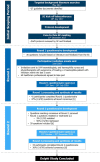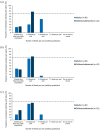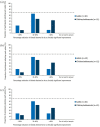Expert opinion on the UK standard of care for haemophilia patients with inhibitors: a modified Delphi consensus study
- PMID: 33995986
- PMCID: PMC8111519
- DOI: 10.1177/20406207211007058
Expert opinion on the UK standard of care for haemophilia patients with inhibitors: a modified Delphi consensus study
Abstract
Background and aims: Despite advances in haemophilia care, inhibitor development remains a significant complication. Although viable treatment options exist, there is some divergence of opinion in the appropriate standard approach to care and goals of treatment. The aim of this study was to assess consensus on United Kingdom (UK) standard of care for child and adult haemophilia patients with inhibitors.
Methods: A modified Delphi study was conducted using a two-round online survey. A haemophilia expert steering committee and published literature informed the Round 1 questionnaire. Invited participants included haematologists, haemophilia nurses and physiotherapists who had treated at least one haemophilia patient with inhibitors in the past 5 years. Consensus for 6-point Likert scale questions was pre-defined as ⩾70% participants selecting 1-2 (disagreement) or 5-6 (agreement).
Results: In all, 46.7% and 35.9% questions achieved consensus in Rounds 1 (n = 41) and 2 (n = 34), respectively. Consensus was reached on the importance of improving quality of life (QoL) and reaching clinical goals such as bleed prevention, eradication of inhibitors and pain management. There was agreement on criteria constituting adequate/inadequate responses to immune tolerance induction (ITI) and the appropriate factor VIII dose to address suboptimal ITI response. Opinions varied on treatment aims for adults and children/adolescents, when to offer prophylaxis with bypassing agents and expectations of prophylaxis. Consensus was also lacking on appropriate treatment for mild/moderate patients with inhibitors.
Conclusion: UK healthcare professionals appear to be aligned on the clinical goals and role of ITI when managing haemophilia patients with inhibitors, although novel treatment developments may require reassessment of these goals. Lack of consensus on prophylaxis with bypassing agents and management of mild/moderate cases identifies a need for further research to establish more comprehensive, evidence-based treatment guidance, particularly for those patients who are unable/prefer not to receive non-factor therapies.
Keywords: Delphi panel; adult; children; consensus; haemophilia; inhibitors.
© The Author(s), 2021.
Conflict of interest statement
Conflict of interest statement: KK: Research support from: Pfizer, Shire, Sobi; Speaker fees from Bayer, CSL Behring, Novo Nordisk, Roche, Shire and Sobi; EC: Research support from: Boehringer Ingelheim, CSL Behring, Grifols, Roche, Shire and Sobi; Speaker’s fees: Boehringer Ingelheim, CSL Behring, Grifols, Roche, Shire and Sobi; Education support: Boehringer Ingelheim, CSL Behring, Grifols, Roche, Shire and Sobi; TF: Education and quality improvement grants from: Sobi; Honoraria from: Bayer; AG: Employee of Costello Medical; FR: Employee of Roche Products Ltd; GT: Employee of Roche Products Ltd; PC: Research support from: Bayer, CSL Behring, Novo Nordisk, Pfizer and Sobi; Consulting fees from: Baxalta/Shire, Bayer, Biogen Idec, CSL Behring, Chugai, Freeline, Novo Nordisk, Pfizer, Roche and Sobi; Speaker’s bureau from: Baxalta/Shire, Biogen Idec, CSL Behring, Novo Nordisk, Pfizer, Roche and Sobi.
Figures




Similar articles
-
Expert United Kingdom consensus on the preservation of joint health in people with moderate and severe haemophilia A: A modified Delphi panel.Haemophilia. 2024 Mar;30(2):306-319. doi: 10.1111/hae.14934. Epub 2024 Jan 19. Haemophilia. 2024. PMID: 38239180
-
When is enough…enough? Developing consensus of definition of failure of immune tolerance induction in patients with haemophilia and inhibitors.Haemophilia. 2014 Jul;20(4):e275-9. doi: 10.1111/hae.12442. Haemophilia. 2014. PMID: 24948406
-
Patient-Centred Management of Well-Controlled Haemophilia: Obtaining Opinions and Definitions Through a Delphi Consensus.J Clin Med. 2025 May 9;14(10):3300. doi: 10.3390/jcm14103300. J Clin Med. 2025. PMID: 40429300 Free PMC article. Review.
-
Immune tolerance induction in paediatric patients with haemophilia A and inhibitors receiving emicizumab prophylaxis.Haemophilia. 2019 Sep;25(5):789-796. doi: 10.1111/hae.13819. Epub 2019 Aug 2. Haemophilia. 2019. PMID: 31373431
-
Optimizing the management of patients with haemophilia A and inhibitors in the era of emicizumab: Recommendations from a German expert panel.Haemophilia. 2021 May;27(3):e305-e313. doi: 10.1111/hae.14010. Epub 2020 Sep 16. Haemophilia. 2021. PMID: 32937002 Review.
Cited by
-
Effect of anterior femoral cortical notch grade on postoperative function and complications during TKA surgery: A multicenter, retrospective study.Open Med (Wars). 2024 Apr 15;19(1):20240932. doi: 10.1515/med-2024-0932. eCollection 2024. Open Med (Wars). 2024. PMID: 38633220 Free PMC article.
-
[Treatment of haemophilia in Austria].Wien Klin Wochenschr. 2024 Jul;136(Suppl 4):75-102. doi: 10.1007/s00508-024-02370-0. Epub 2024 May 14. Wien Klin Wochenschr. 2024. PMID: 38743098 German.
-
Total knee arthroplasty in patients with haemophilic arthropathy is effective and safe according to the outcomes at a mid-term follow-up.J Orthop Traumatol. 2022 Jul 11;23(1):31. doi: 10.1186/s10195-022-00648-5. J Orthop Traumatol. 2022. PMID: 35819639 Free PMC article.
-
Nonsevere Hemophilia: The Need for a Renewed Focus and Improved Outcomes.Semin Thromb Hemost. 2025 Feb;51(1):58-67. doi: 10.1055/s-0044-1786358. Epub 2024 May 11. Semin Thromb Hemost. 2025. PMID: 38733982 Free PMC article. Review.
References
-
- Oldenburg J, Brackmann HH, Schwaab R. Risk factors for inhibitor development in hemophilia A. Haematologica 2000; 85: 7–13. - PubMed
-
- Mancuso ME, Mannucci PM, Rocino A, et al.. Source and purity of factor VIII products as risk factors for inhibitor development in patients with hemophilia A. J Thromb Haemost 2012; 10: 781–790. - PubMed
-
- Ingerslev J. Hemophilia. Strategies for the treatment of inhibitor patients. Haematologica 2000; 85: 15–20. - PubMed
-
- Srivastava A, Brewer A, Mauser-Bunschoten E, et al.. Guidelines for the management of hemophilia. Haemophilia 2013; 19: e1–e47. - PubMed
-
- Kempton CL, Meeks SL. Toward optimal therapy for inhibitors in hemophilia. Hematology Am Soc Hematol Educ Program 2014; 1: 364–371. - PubMed
LinkOut - more resources
Full Text Sources
Other Literature Sources
Miscellaneous

